|
|
|||||||||||||||||||||||||||||
|
about later. Architecturally, it would stir nobody. What is more, little seems to be known of its history. “Why would you bother” seems to be the very reasonable question? Pevsner wrote about it but he wrote about every church. And in true Pevsner fashion he proceeded to barely touch on the real treasure of this church which is its west tower or, to be more accurate, the gargoyles and carvings that adorn it. Pevsner, you see, “did” architecture but hardly “did” mediaeval artisanal art at all. What everyone who can be bothered seems to know about the church is that a man called Anthony Ellys built that tower in 1519. At eighty feet in height, it is a big bugger. A muscular lock forward of a tower. Commonsense tells you there must have been a tower there before this one but Ellys swept it away. Why? Because this tower is here to remind everyone of the man who commissioned it. As an act of hubris it outshines all of those grand tomb chests and monuments you see inside churches. Anthony was a wool merchant and member of the wealthy and prestigious Calais Wool Staple. He lived in what is now called “Ellys Manor House” adjoining the churchyard. All English wool had to be exported via Calais. It helped with regulation of the trade and - even more importantly, at least to the King - ensured that all of those exports were properly taxed! These boys of the Calais Staple were seriously rich. In Gloucestershire and Suffolk we talk of “wool churches” - magnificent cathedral-like parish churches paid for by the wool merchants whose descendants commemorated them by impressive monuments and floor brasses. The East Midlands was also wool country although “wool church” is not a term used in the vicinity. Great Ponton’s is, though, very definitely a wool tower. In nearby Stamford you can see Browne’s Hospital, endowed by the fabulously rich William Browne, another man of wool althouh a few decades before Ellys’s time. I have never seen anything quite like the sculptural display here. There are eight gargoyles: two on each side. They are no ordinary gargoyles, We are all used to the dragon/monster model of gargoyle that appear on literally thousands of churches and cathedrals in England. Great Ponton has no such mundanity. Each is a little sculptural gem that defies explanation. With one exception. There is a human figure and it is occasionally averred that this figure has the earliest sculptural representation of spectacles in England. Nobody else seems to have made the obvious (to me) leap to say this is surely a representation of Anthony Ellis himself peering through spectacles, wearing ruffed sleeves and holding a pen. The symbols of the Staple and the Ellys are prolific on this tower, How, one might reasonably ask, can this figure - clearly a “real” person - be any other than Ellys himself? All of the gargoyles are superb and entertaining. But there is more. The masons have put sculptures all over the tower. Some of them are built with remarkable ingenuity into the angles between the tower wall and buttresses. Men - I think the masons were portraying themselves - and beasts cling to the sides and contort themselves like Quasimodo scaling the tower of Notre Dame. Many are grievously weathered, sadly. You have to look carefully at them - don’t even think of coming here without binoculars - to understand what masterpieces of sculptural craftsmanship they were. Ellys must have paid top dollar for these guys. So there you have it. Never mind the architecture: you have superb sculpture here; you have the context of a patron enriched by the wool staple; you have his hubris that has lasted half a millennium, all in a settlement for which “hamlet” might seem too grand a description. I am not going to bore you with a minute description of the “architecture”! I am going to bore you plenty about the photo gallery! |
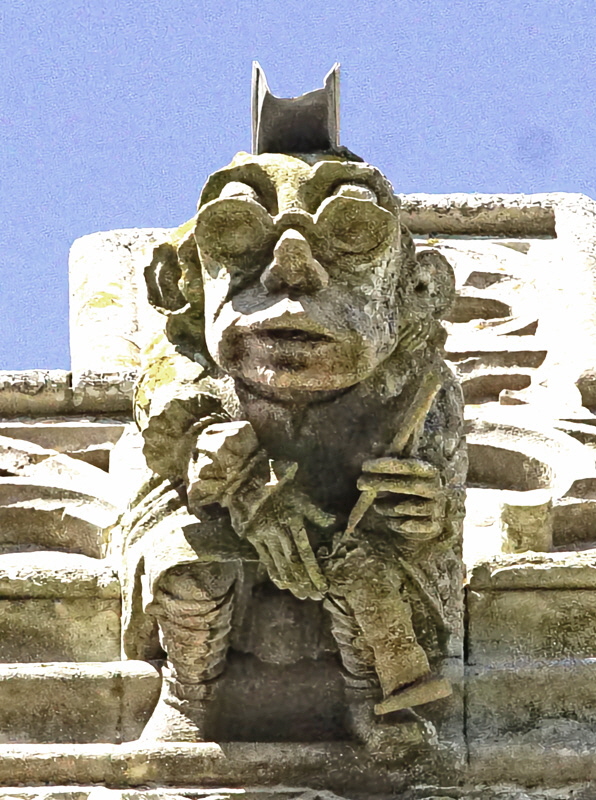 |
 |
|||||
|
Left: Surely the image of Anthony Ellys himself with the first known sculptural representation of spectacles in England. He holds a pen and on his knee is a strip pf parchment upon which, presumably, he records his deals or his accounts. Note the detail of his quite rustic boots. His left sleeve (as we look at it) is ruffed. With is bulbous eyes and protruberant ears there is a whiff of caricature here. This is a merchant, not a nobleman. A man of business. Note the finely carved fingers and wonder that this gargoyle is still intact after 500 years. Right: Well, this chap is grotesque all right with his goblin ears. He seems to be wearing some kind of tabard.What is he holding? One theory (my favourite) is that this is another satire on the apothecaries of the day, the insult being that they sold flasks of their own urine as cures. It is usually an ape, however, holding the flask - and usually carved on misericords. Another theory is that he is holding a bag of money. Perhaps he is a miser? But the feet don’t look humanoid. It is always hard to make out what is going on between the legs of sculpted grotesques but is this man showing his - er - wedding tackle? |
||||||
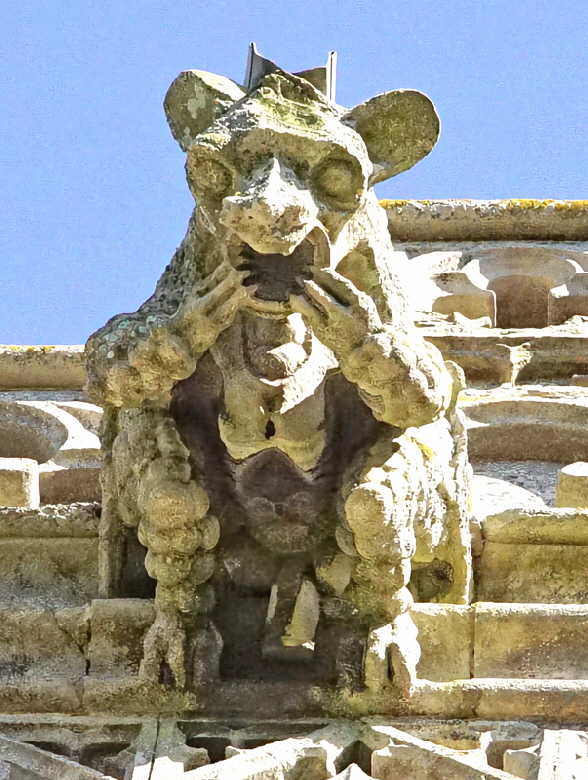 |
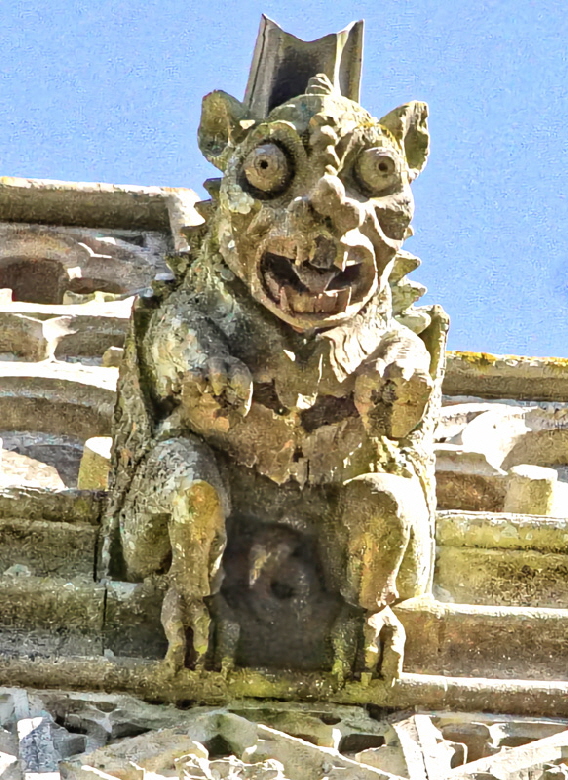 |
|||||
|
Left: Well, this one defies description, doesn’t he? You have to love that look of having been caught in the act of something naughty! If you look carefully you can see what might be causing that expression. There seems to be a bearded man either where his “stomach” would be or between his legs. I am not sure what that other cylindrical thing is between his legs. He seems to have a cloak around his shoulders. Right: Like the creature on the left, this gargoyle clings to the parapet with three-toed clawed feet. He has a “hosepipe” between his legs. He too might be wearing a cloak. Or are they wings? |
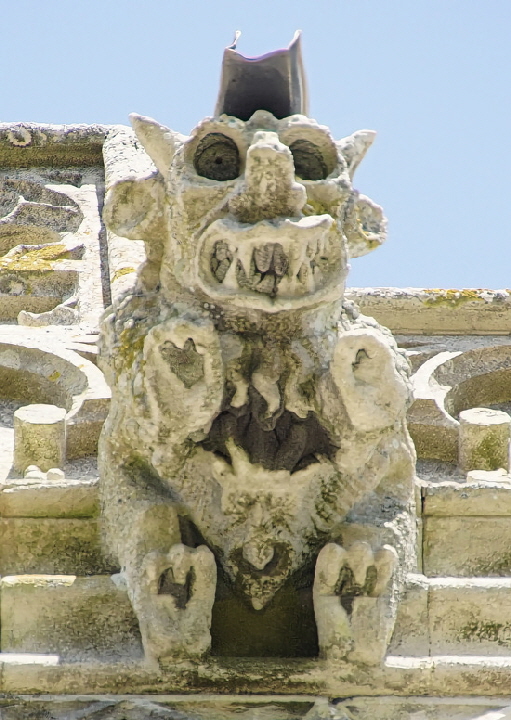 |
|||||||||||||||||||||||||||||||||||||||||||||||||||||||||||||
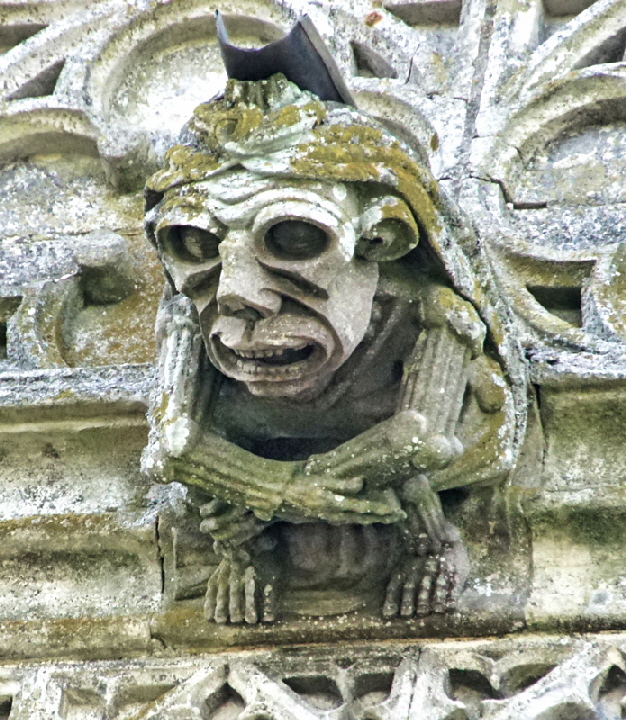 |
|||||||||||||||||||||||||||||||||||||||||||||||||||||||||||||
|
Left: From the grotesque to the macabre. Is this what the sculptor thought the human skeleton looks like? He has five toes on each foot. Or is it just a monstrous creation? He wears a strange cloak. Right: Another frightener. We are back to the three-toed feet again (so much less trouble than carving five!). Look closely and there is an equally monstrous head in his hands. Bitten off his body with those ferocious teeth presumably. Just a little bedtime snack. |
|||||||||||||||||||||||||||||||||||||||||||||||||||||||||||||
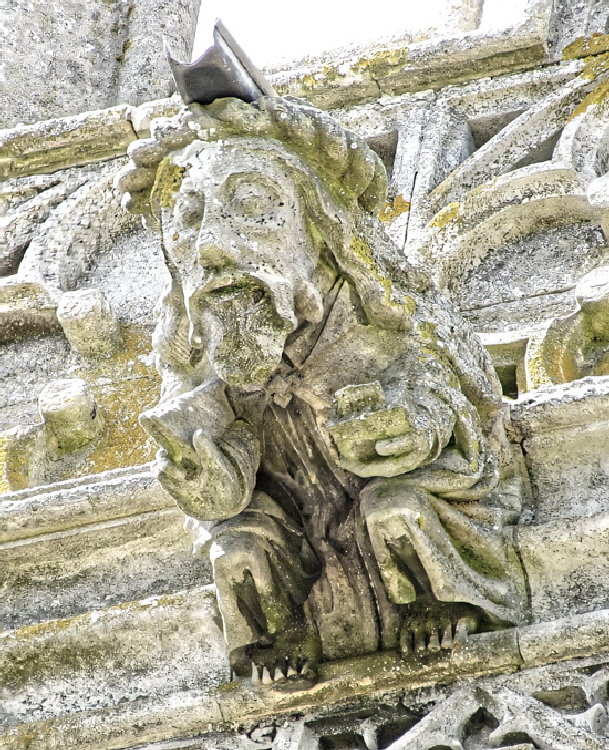 |
|||||||||||||||||||||||||||||||||||||||||||||||||||||||||||||
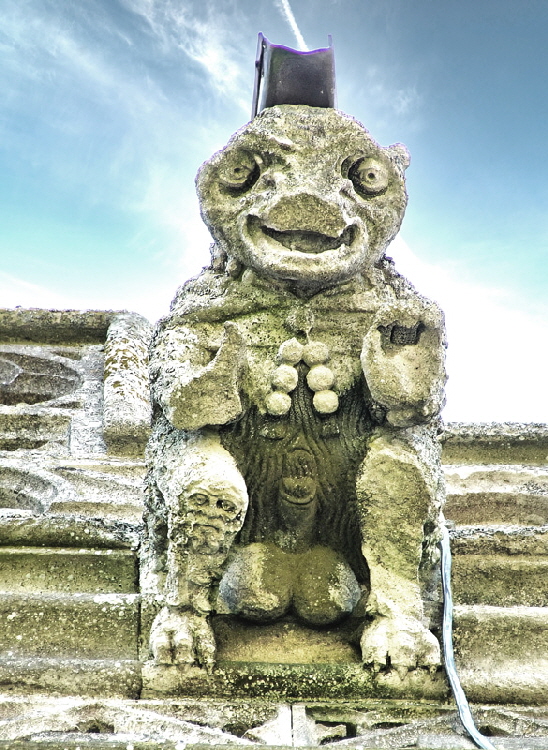 |
|||||||||||||||||||||||||||||||||||||||||||||||||||||||||||||
|
Left: Compared with the other gargoyles, this one is sedate. A man obviously - with a book or parchment in one hand? And what is that strange headgear? Right: Well, another grotesque, alien-looking figure. Two things to note: one the left knee as you look at him there is a face. The other thing is right there between his legs where it looks like someone or something is enjoying sucking on the creature’s...er...tackle. His testicles are monstrous! How weird is this? You might be curious as to why the underside of the carving is black, almost as if it has been painted? The same is true of most of the carvings here. The answer is in chemistry. The stone here - and in most of the East Midlands - is limestone. The burning of countless domestic fires over countless years and then the onset of industrial pollution contrived to produce that dreadfully damaging acid rain that was very much part of the environmentalist vocabulary of my early adult years. That acid rain reacted with the limestone to turn the surface of the stone to gypsum. The irony is that rain itself washed the gypsum away, but not on the sheltered undersides of our sculptures. Hence the top surfaces tend to be white and the undersides black or dark grey. This is counter-intuitive as the inner surfaces are to some extent protected from the elements.! |
|||||||||||||||||||||||||||||||||||||||||||||||||||||||||||||
|
Gargoyles fascinate in so many ways. The word has become synonymous with anything ugly and is popular with misogynists, all of whom of course have the looks of Apollo and are ripped like Adonis. But a gargoyle, strictly speaking, is a grotesque creature (apart from Anthony Ellys) with the function of removing water that is trapped behind a roof parapet. In this case, unusually, the gargoyles support lead half-pipes that drop the water onto the heads of the unsuspecting passing parishioners. Any other form of ugly or monstrous carving is a “grotesque”. But you already knew that, didn’t you? Nobody knows why it became obligatory to make gargoyle sculptures grotesque. Nor is it known why the masons carved grotesques at all. Academics who would die rather than admit their own ignorance sometimes talk of “apotropaia”, a laughably pompous word that means, roughly, distracting evil spirits or the Devil away from a sacred place. That practice is indeed known in some primitive backwaters of the world although I rather doubt the natives talk of apotropaia. The arguments against are several. Firstly, although gargoyles and grotesques seem ubiquitous, in fact many churches have none at all and don’t seem to have suffered unduly from diabolical intervention. Secondly, if this were indeed the reason we might have expected to have at last one record of it as a consideration in church design. There are none, not even in Cathedral records - and we all know Cathedrals loved their gargoyles. There is not word handed down to us to describe this function of the ubiquitous gargoyle, If this was ever the origins of the tradition I think we can safely assume that it soon became simply a matter of habit and tradition of the masons. But if it was only a craft tradition that does not explain why gargoyles such as these at Great Ponton are so elaborate. In the unlikely event that a monster was indeed seen to distract the devil or if it was just a piece of everyday ornamentation why not just carve any old simple dragon? What fascinates about the Ponton gargoyles is that with the exception of Ellys and the other human figure only the sculptor himself would know what the symbolism was meant to represent. And why go to such trouble for a sculpture that was to be eighty feet above ground where even the real Anthony Ellys with his spectacles would struggle to see it? I am sure Ellys and his family were ticked pink at the semi-facetious depiction of his self. I am sure they got to see it before it was raised to the top of the tower and Ellys himself might even have asked for himself to be commemorated, as he is all over the rest of the tower, as we shall see. But what of the rest? If there is symbolism at the macro level (the miser with his bag of gold or apothecary with his flask of urine) how do you explain the micro detail of a figure with a face on his knee and a strange figure indulging in some form of fellatio on his grotesque genitals? The sculptor must have had something in mind but we must suppose it was literally an ephemeral figment of his imagination and that nobody else at the time or since has known what he meant by it. How wonderful to have created something that has us guessing five hundred years later? It is my belief that much of this owed itself to the culture of “The Lodge”. For those of you who unforgivably have not read my polemic “Bums, Fleas and Hitchhikers” (what are you waiting for?) the masons would build an open-sided shed at the side of the building called a lodge (derived from the Italian word “loggia” meaning a covered passageway). There the head mason would draw his plans, some fine sculpture might be carried out, shelter from the rain might be afforded in extremis and perhaps some eating and certainly some drinking took place. With maybe a dozen or more masons away from home belching, farting, joking and womanising under its roof what sort of culture do you think existed? I think there you have the answer to why genitalia were so in vogue for the Ponton masons. The gargoyles might have been destined to be raised to a level where their details could not be seen from ground level until we came along with our binoculars and telephoto lenses: but while they were carving them and before they were actually put in place I would wager that the men thoroughly enjoyed their own and each others’ taste for the bizarre and the obscene. |
|||||||||||||||||||||||||||||||||||||||||||||||||||||||||||||
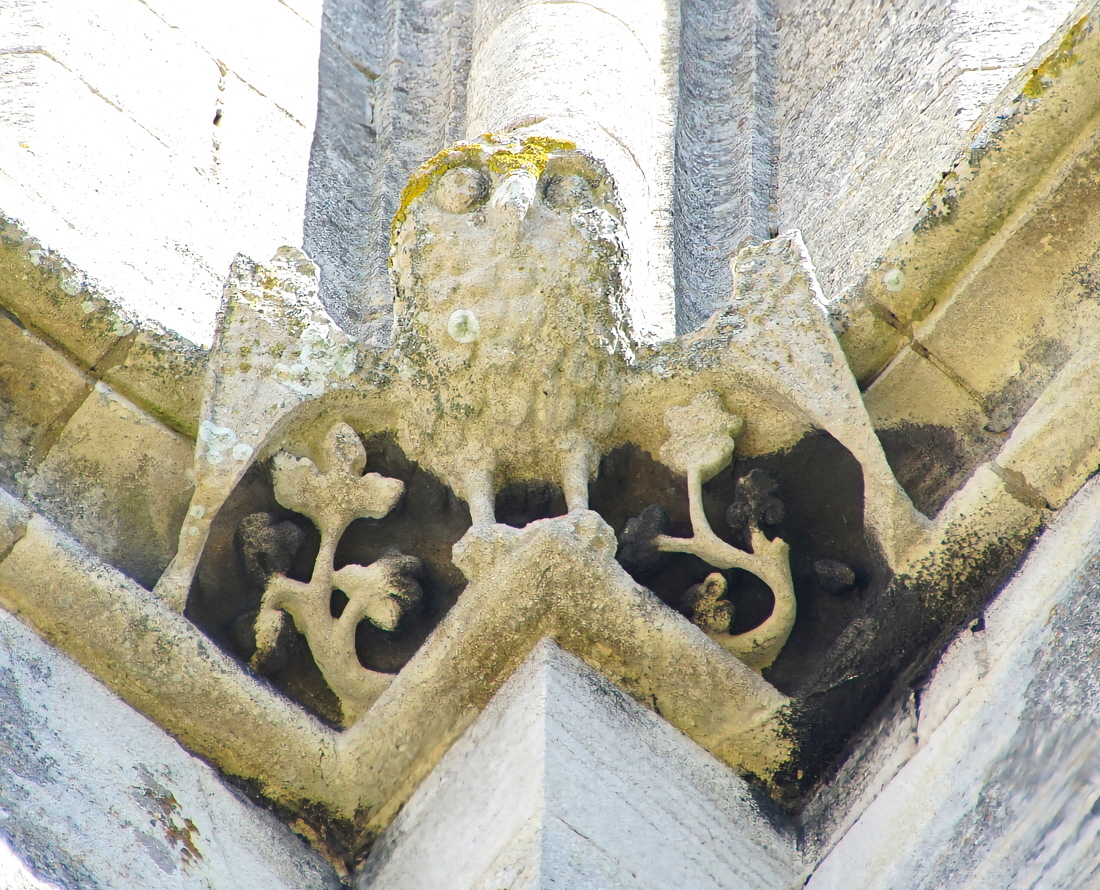 |
|||||||||||||||||||||||||||||||||||||||||||||||||||||||||||||
|
This owl perches, as do many of the best carvings here, athwart the buttresses. Just look at this closely and see what a remarkable piece of work it is. The sculpture is part of a single w-shaped section of cornice that is one piece. The mason must have started with a single block of stone and chiseled out a block with the w-shaped profile. Then he somehow fashioned the cornice profile whilst undercutting the stone to produce the 3-dimensional image not only of the owl but of foliage within the cornice space itself. And it had to fit exactly between the cornicing either side of it. Note the dark gypsum in the recesses of the cornice, a legacy of acid rain and atmospheric pollution- see above. |
|||||||||||||||||||||||||||||||||||||||||||||||||||||||||||||
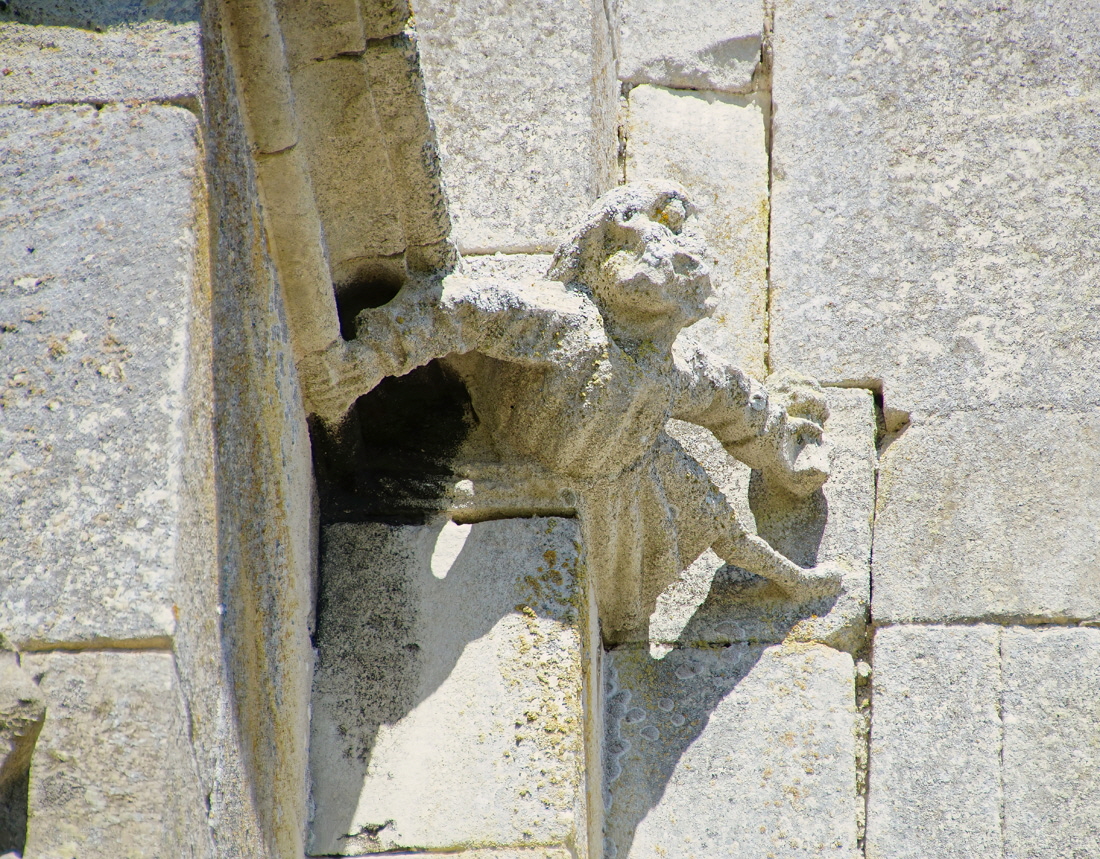 |
|||||||||||||||||||||||||||||||||||||||||||||||||||||||||||||
|
I am convinced in my own mind that this buttress inset carving depicts a stonemason. Whatever it is, it is another example of near-miraculous skill. The left part of his body is still part of a block that is part of the buttress itself. The right hand side of the sculpture is not attached but part of another block of stone that is part of the tower wall. The right hand of the figure (nearest to us) is holding onto a piece of cornice. In other words, from a single block of stone the mason has managed to shape a piece that fits into a space in the buttress, into the wall of the tower and which provides a short piece of cornice and then he has carved out the figure of a man. All from one block of stone! |
|||||||||||||||||||||||||||||||||||||||||||||||||||||||||||||
 |
|||||||||||||||||||||||||||||||||||||||||||||||||||||||||||||
|
I forget which aspect of the tower this is, it is richly decorated and the birds are grateful for its perching points. Note the very avant garde design of the tracery. It is an innovative design, even for 1519. I believe it is meant to represent Ellys’s wool merchants mark. See the interior picture further down the page. A frieze of shields adorns the parapet. Before the Plague of 1348 and the consequent inexorable eradication of feudalism it would have been unthinkable for a commoner to have accumulated the wealth to commission such works. Pevsner was somewhat sniffy about the parapets and pinnacles, suggesting they don’t “fit”. But he ignored the gargoyles. Architecture thrilled him, “barbarous” art did not. |
|||||||||||||||||||||||||||||||||||||||||||||||||||||||||||||
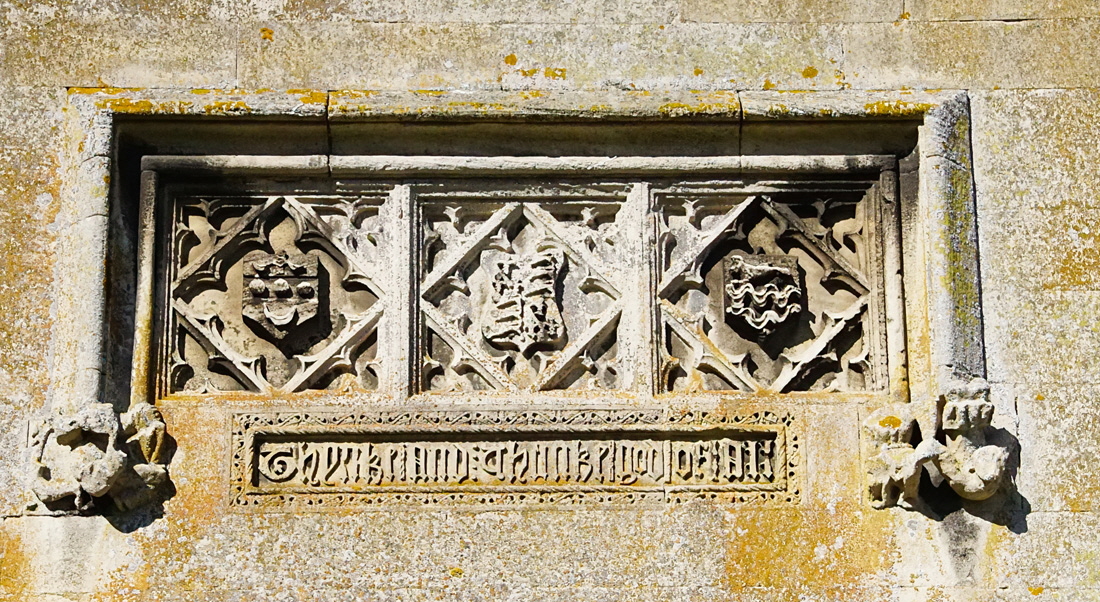 |
|||||||||||||||||||||||||||||||||||||||||||||||||||||||||||||
|
Few towers are as personalised as this one. The words say “Think and Thank God for All” and one rather thinks that Anthony had a lot to be thankful for.! The left hand crest is the arms of the Ellys (or Ellis) family..There have been many variations over the centuries but the scallop shell and crescent moons were consistently present. To the right is the arms of the Calais Staple and we shall see more of this. The central crest is damaged and hard to discern but the sets of three lions couchant at top right and bottom left mean this is probably the Tudor arms of England and that the two damaged quarters show the fleurs de lys. |
|||||||||||||||||||||||||||||||||||||||||||||||||||||||||||||
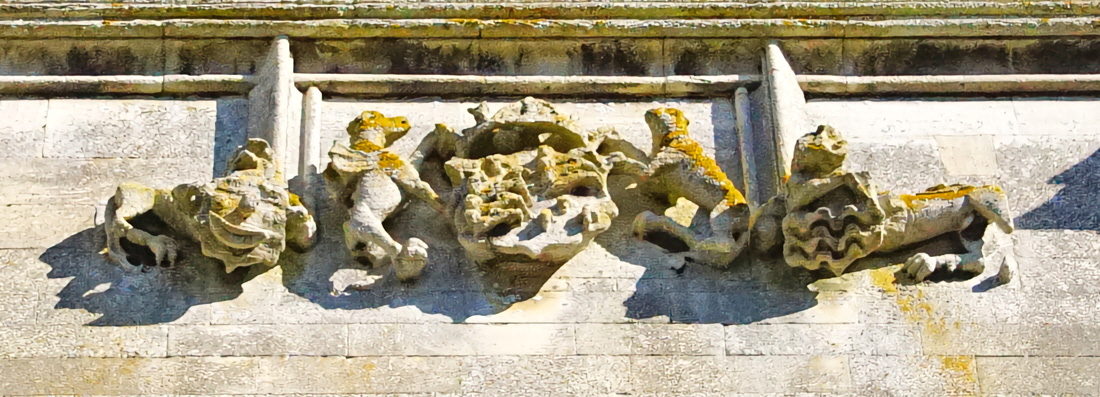 |
|||||||||||||||||||||||||||||||||||||||||||||||||||||||||||||
|
I think, again, that the arms here are of England. To the right is a rather peculiar mish-mash of the Calais Staple arms (see below) that has waves of the sea surmounted by a lion. Here the lion seems to be holding the waves. The left-hand carving is damaged but the crescent moon of the Ellys arms is obvious. |
|||||||||||||||||||||||||||||||||||||||||||||||||||||||||||||
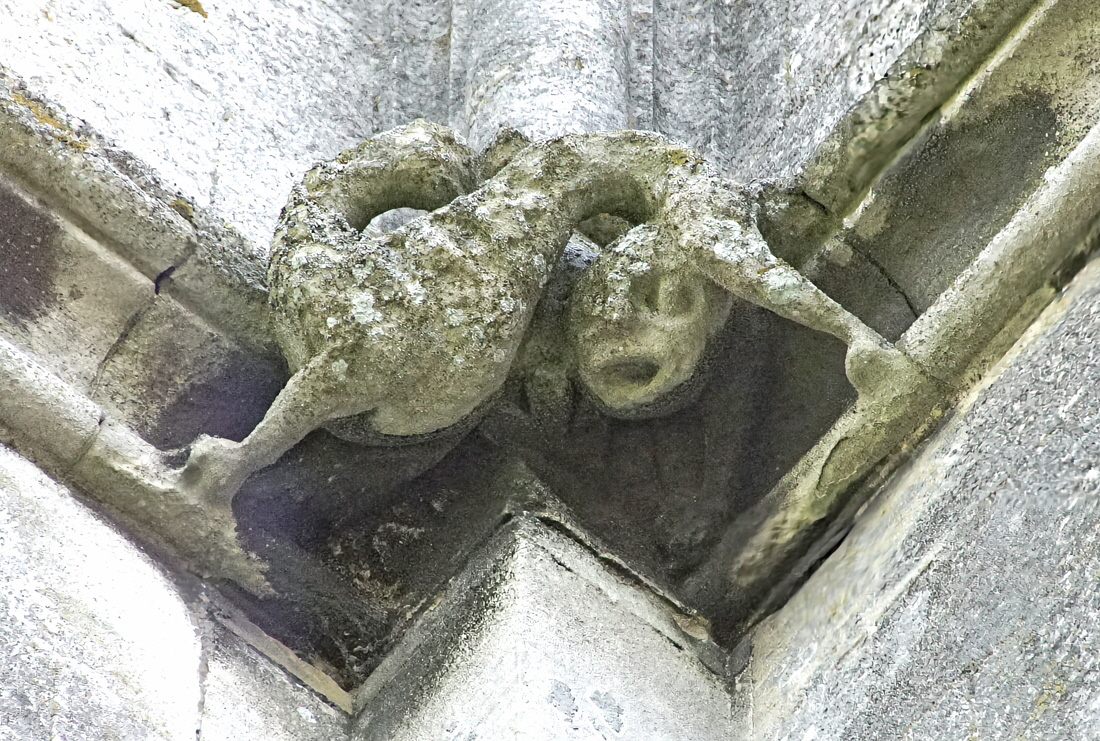 |
|||||||||||||||||||||||||||||||||||||||||||||||||||||||||||||
|
I think of this buttress corner carving as “The Contortionist”. It reminds me of a cat that has - as cats are wont to do - climbed something and found it can’t get down! Again, I invite you top marvel at what the mason has achieved here. I think there are four legs but the black gypsum is hiding the inside ones. |
|||||||||||||||||||||||||||||||||||||||||||||||||||||||||||||
 |
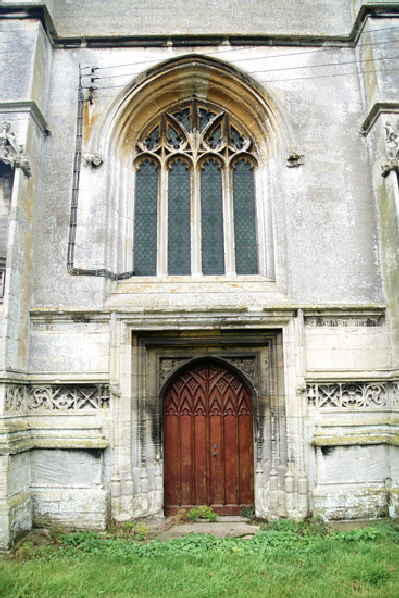 |
||||||||||||||||||||||||||||||||||||||||||||||||||||||||||||
|
Left: Another buttress carving. It is weathered and it looks like a limb is missing but i can’t see how it would have fitted in with the leaf design to the left of the man. Right: The west door is square but note the spandrels (the spaces between the arch and the square surround. They have carved designs. See below. |
|||||||||||||||||||||||||||||||||||||||||||||||||||||||||||||
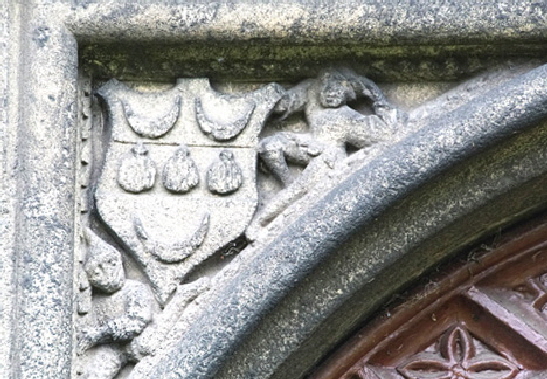 |
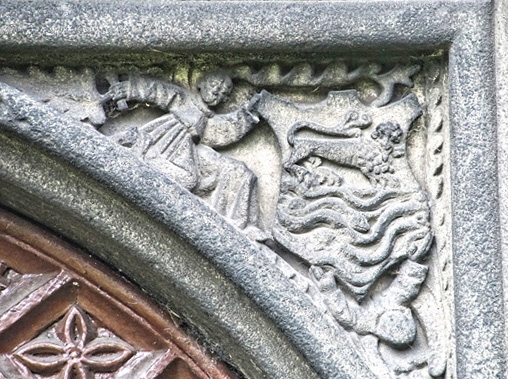 |
||||||||||||||||||||||||||||||||||||||||||||||||||||||||||||
|
The doorway spandrels. Left: We have the arms of the Ellis family again with scallop shells and crescent moons. Someone leans insouciantly to its right. In the bottom left a gnome-like figure. Right: Unsurprisingly, we see the arms of the Staple again. Someone- Ellys? - is dragging something (it looks like a leaf but surely it can’t be?) towards the coat of arms. |
|||||||||||||||||||||||||||||||||||||||||||||||||||||||||||||
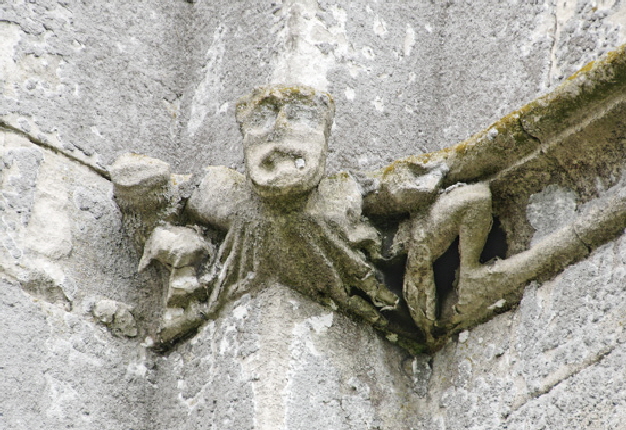 |
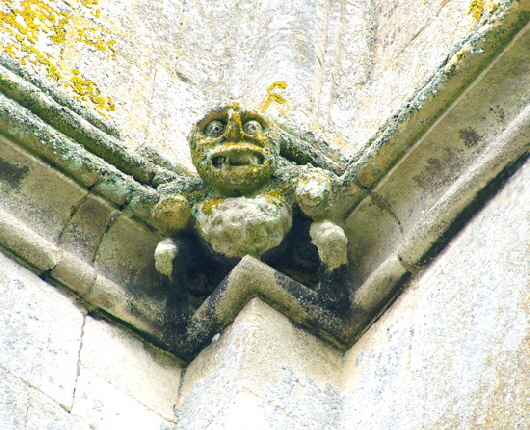 |
||||||||||||||||||||||||||||||||||||||||||||||||||||||||||||
|
Two more buttress sculptures. |
|||||||||||||||||||||||||||||||||||||||||||||||||||||||||||||
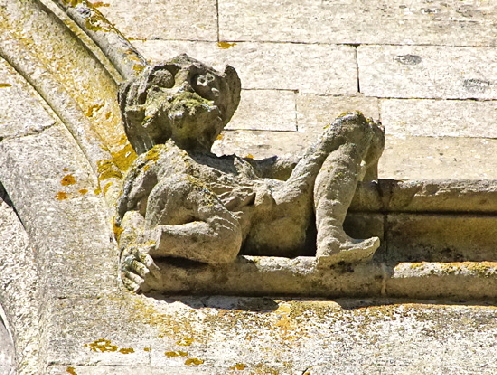 |
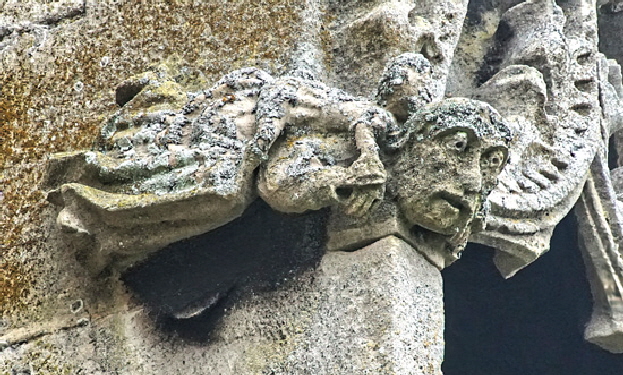 |
||||||||||||||||||||||||||||||||||||||||||||||||||||||||||||
|
Left: There are label stops at the ends of the drip moulds around the windows. This is another mini-masterpiece, a far cry from your usual label stops. This chap has just stopped for a rest sixty feet from the ground and casually surveys the world. Right: The church has some empty niches. Whatever was in them would have been short-lived with the Reformation on the horizon. I captured this rather nicely-carved figure on one of the niches. |
|||||||||||||||||||||||||||||||||||||||||||||||||||||||||||||
 |
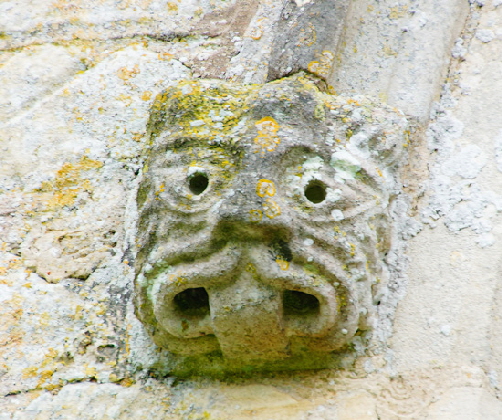 |
||||||||||||||||||||||||||||||||||||||||||||||||||||||||||||
|
Left: The top of one of the niches. There are plenty of carvings again. Note inside the top of the niche seems to be a flower - possibly a Tudor rose? Right: This is a little bit of a curiosity - a label stop that looks anachronistically somewhat Romanesque. |
|||||||||||||||||||||||||||||||||||||||||||||||||||||||||||||
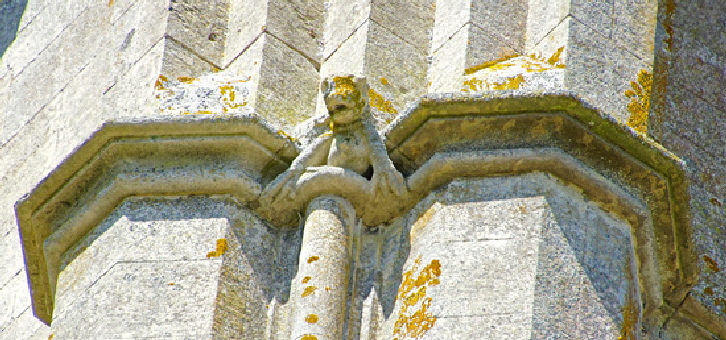 |
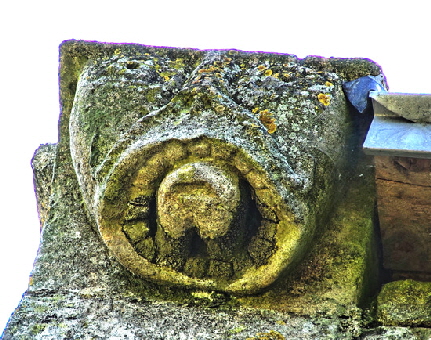 |
||||||||||||||||||||||||||||||||||||||||||||||||||||||||||||
|
Left: Another buttress carving. Right: Another curiosity. This carving is actually on the older north east of the church and not part of the tower. |
|||||||||||||||||||||||||||||||||||||||||||||||||||||||||||||
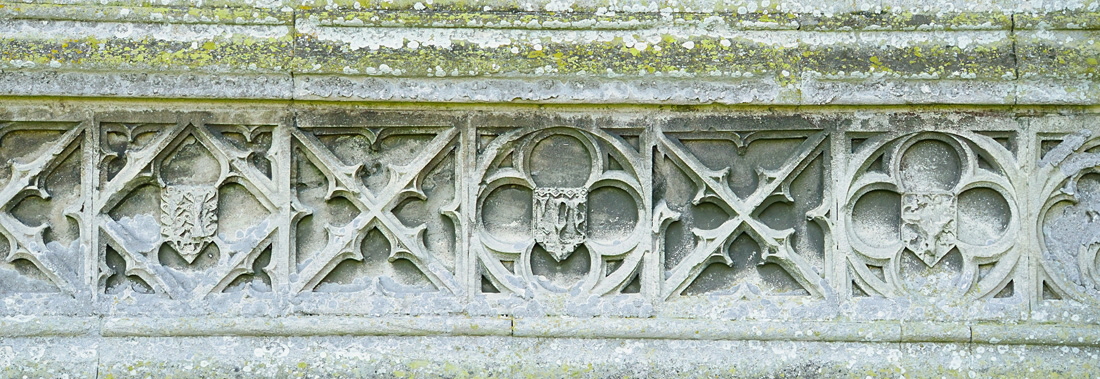 |
|||||||||||||||||||||||||||||||||||||||||||||||||||||||||||||
|
A section of the frieze around the base of the tower, Every other square contains a coat of arms. We cannot know whose arms they are. |
|||||||||||||||||||||||||||||||||||||||||||||||||||||||||||||
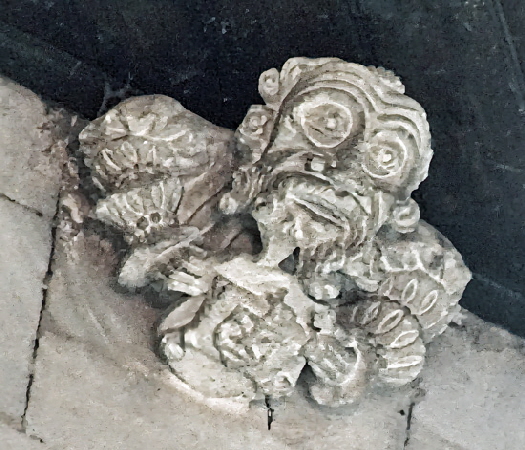 |
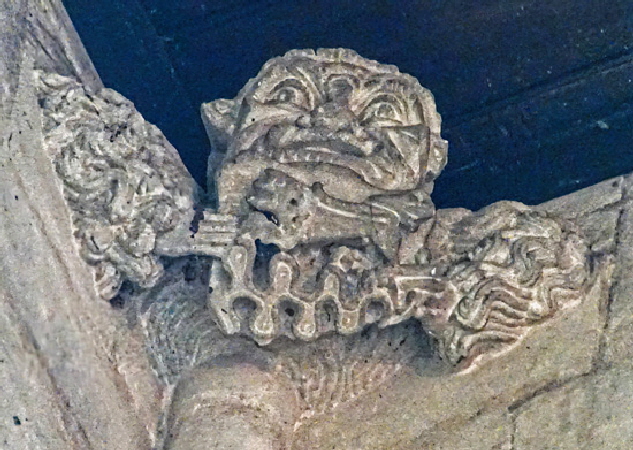 |
||||||||||||||||||||||||||||||||||||||||||||||||||||||||||||
|
Now - inside the church at last. But we are looking here at three of four carvings that are in the corners of the tower ceiling. The corners are extremely dark so thse are the best pictures I could get. Left: This is surely another representation of Anthony Ellys. The sculptor has not tried to carve spectacles but he has very clearly represented them bu scribing circles around the eyes. He holds a shield with what I think is likely yo be Ellys’s merchants mark. Now look at the tower window tracery in an earlier picture. I think it was an attempt to reproduce this symbol. Note the puffed sleeves. Right: This figure is holding the lion and waves of the Calais Staple - oddly not enclosed within a shield, |
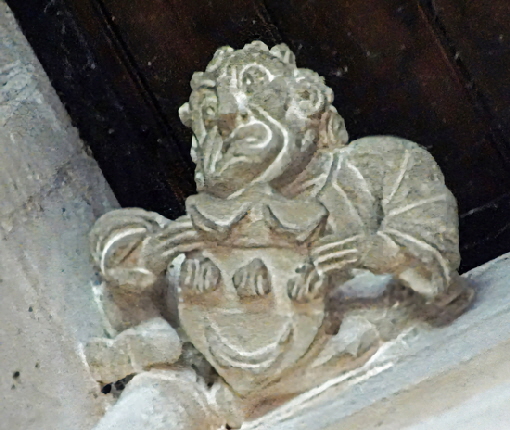 |
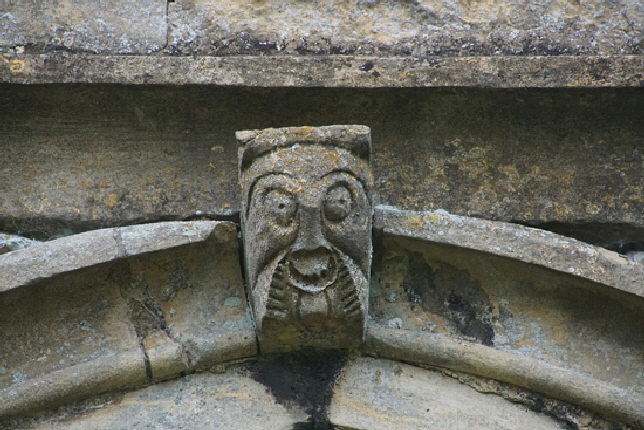 |
||||||||||
|
Left: And here we are again. A man holds the Ellys arms. Right: Another little departure from the tower - carving over the south door. |
|||||||||||
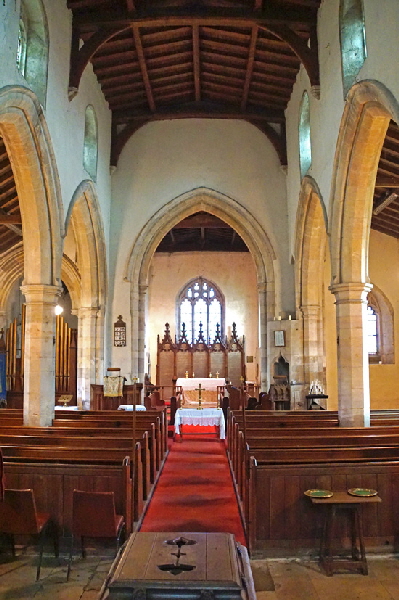 |
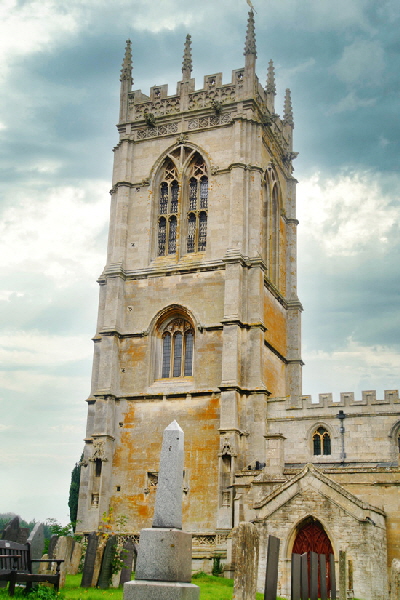 |
||||||||||
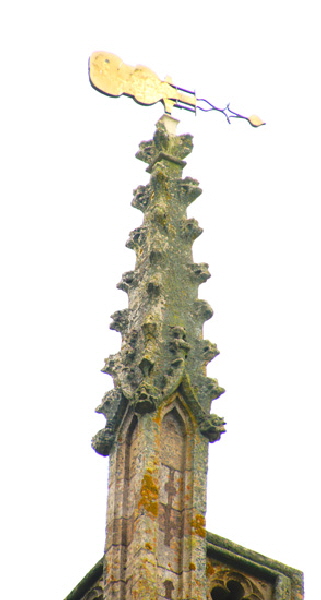 |
|||||||||||
|
Left: Looking east along the nave. Really, this is about as ordinary as a nave and chancel gets so there is little point in spending time talking about it. It is mainly in the Perpendicular style, although there are traces of Early English, and all of it pre-dates the tower. Centre: The south west corner of the church. Note (although it is difficult to see) that the tracery of the second stage of the tower is the same as that of the top stage. I do believe this is meant to be Ellys’s merchants mark and it is in keeping with the general sense of his hubris Right: One of the pinnacles which Pevsner avers “do not quite fit the stage below”. To be honest I don’t know what he is talking about! Anyway, the point of interest here is the violin weather vane. The story - which I would like to think is true - is that in the seventeenth century a local fiddle player made enough money from playing for the parishioners to be able to travel to America to make his fortune.. When he returned he had this weather vane (it’s actually a copy) made for the church out of gratitude. |
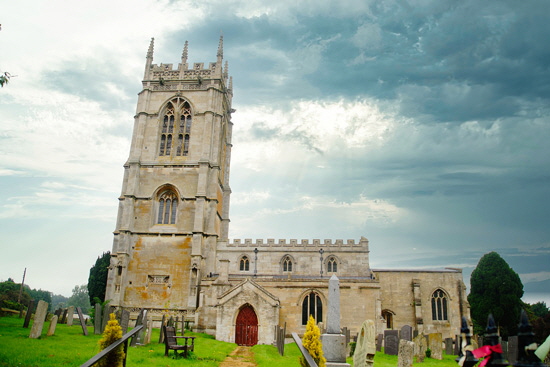 |
 |
|
Left: The church from the south. Right: This is the Ellys Manor House. It was built by Anthony for his home and it adjoins the churchyard. A private building, It was open to the public for some years but I am unsure of its status at the moment. It has one of the finest collections of mediaeval domestic wall paintings in England. |
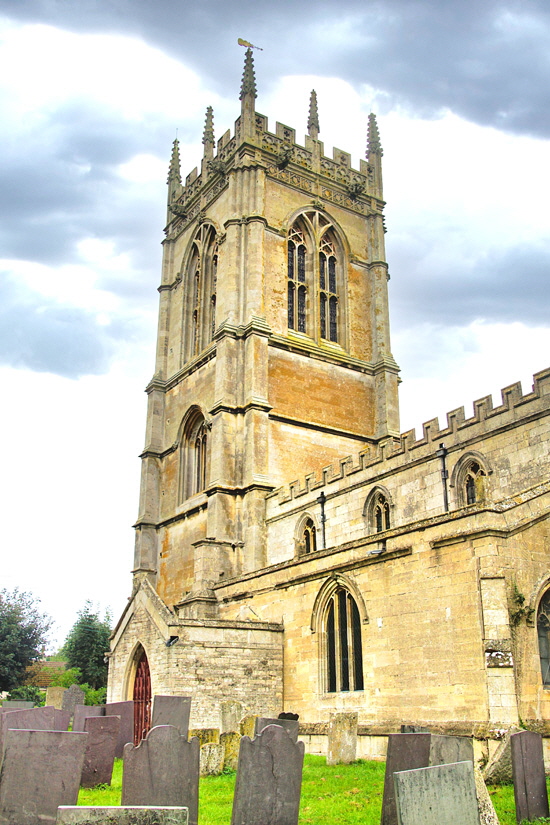 |
|
|
|
|
I hope you have enjoyed this Page and, perhaps, many more besides. Could you help me to make it better still and preserve its future? |
